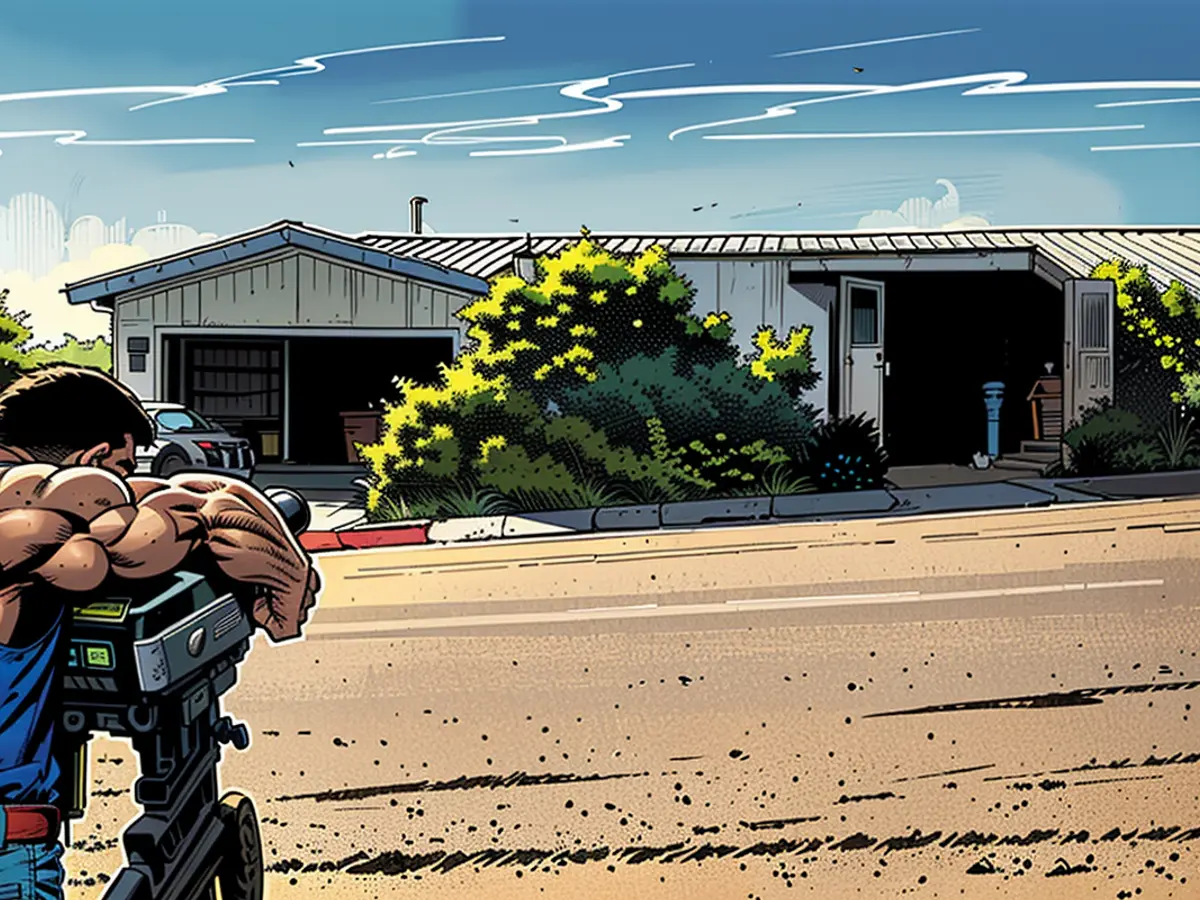ARE WE SET UP FOR CATASTROPHE?
- This opinion piece from CNN Experts discusses strategies for better preparing for disasters:
- Million-dollar disasters looming around the corner
Perspective: In a Flash, a Wildfire Drastically Altered the Landscape
We hurriedly gathered our pets - two large Newfoundland dogs and a cockatiel, shoved a few photographs into a laundry basket, and fled in a panic, driving through dense smoke and roaring flames to escape the notorious Cedar Fire, which ravaged over 270,000 acres in San Diego County, setting a precedent for today's climate-induced "mega fires."
Behind us, our home and everything we owned turned into ashes - one of over 3,500 dwellings destroyed in a two-week ordeal of ferocious fires that erupted across Southern California that autumn. But we were alive! Somehow, against all odds, we had survived.
It happens in an instant. One day, one moment, everything appears peaceful. The next instant, everything drastically changes. Suddenly you find yourself homeless, disoriented, reliant on the kindness of strangers for life's fundamentals – shelter, a bed, a few borrowed shirts and jeans. And when you look ahead, trying to rebuild your life, the path seems daunting and risky. Because it is.
Regardless of fire or flood, earthquakes or volcanoes, storms or tsunamis, disasters annihilate both physical and emotional realms. A comprehensive response to the apocalyptic scenes we're witnessing with increasing regularity as our planet heats up should comprise both material and emotional aid. Temporarily shelters, government-mandated emergency lodging, and full-insurance replacement policies aren't sufficient to mend traumatized minds and hearts.
I learned these lessons firsthand. Spending the past decade, I've shared our story to help others be better prepared than we were, especially as the probability of major natural disasters increases everywhere, even in areas previously deemed safe.
My own preservation advice condenses into four points I refer to as the LIVE Equation:
• Pay heed to your instincts. If you sense danger, leave immediately, not waiting for an official evacuation notice that may never come.• Inform yourself. Stay informed about real-time news and weather conditions.• Prioritize your life over possessions. Prefers saving time over loading vehicles with replaceable belongings. Upload crucial photos and documents to the cloud instead. Assemble easy-to-grab "go bags" with valuables, medications, and essential supplies. Keep wallets and car keys within reach, and gas tanks over half full.• Above all, evacuate early. The majority of civilian deaths occur when people postpone departure too long.
A quick online search should provide all the information needed on disaster preparation. It's more challenging to find resources that assist survivors in managing the aftermath. Recovery efforts mainly focus on economic resilience – repairing infrastructure, rebuilding homes and businesses. Personal resilience reinforcement is typically left up to the survivor.
Emotional healing takes time. Grief doesn't stick to schedules. But my personal fire experience taught me that faith, emotional support, and simple resilience-boosting strategies can hasten and smoothen the comeback journey.

As news of the Cedar Fire's devastation circulated, those of us who lost our homes heard ourselves referred to as "fire victims." I felt offended by that term. Victim? I could barely comprehend a more disempowering moniker. Moreover, how could I be a victim? I was alive, unlike 12 of our canyon neighbors listed among the fire's 15 fatalities.
As another neighbor later put it: "We buried the victims. The rest of us are survivors."
Most Southern California fire survivors I interviewed for my book, "The Fire Outside My Window," felt similar. But some, either broken or bitter, viewed themselves as victims. Shockingly, it didn't seem to correlate with how much, or how little, they'd lost to the flames.
That's when I understood: It's a choice! We may not possess control over what transpires to us, but we can still opt for our response. Austrian psychiatrist Viktor Frankl, a man who lost his family and his freedom during the Holocaust, discovered this insight even amid extreme suffering.
"Everything can be taken from a man but one thing: the last remnant of human freedom – to choose one's attitude in any given set of circumstances, to decide one's own path," Frankl wrote.
A substantial body of research on our human resilience affirms the significance of choice in a healthy recovery journey. Victim or victor? You get to decide the role you'll play as your story unfolds.
Gratitude is another critical practice confirmed to support emotional healing. Finding something merely to be thankful for – simply being alive is an excellent starting point – can alleviate despair and protect us from the harmful quicksand of bitterness and blame that obstructs recovery and growth.
Patience with the process, combined with faith that your innate resilience will carry you through, forms another fundamental piece of the resilience puzzle. Believe that you are part of a resilient universe; resilience is in your genes.
Connecting with others, accepting and requesting aid rather than appearing self-reliant, is also essential to recovery. (No shame here. Even superheroes rely on mentors, allies, and higher powers.)
And finally, it's crucial to keep moving forward, despite the sluggish pace. Slowly releasing attachments to all that was lost allows us to embrace a new era filled with new opportunities and possibilities.

In our situation, we were fortunate to have enough insurance to rebuild our home in the canyon environment we adored. People might wonder why we chose to rebuild in the same location. The straightforward response: Because it was our home. And there's nothing more eagerly sought by survivors after losing their homes than regaining them.
For our new house, we focused on creating a design that catered to our specific needs, with a stronger focus on fire safety. We employed fire-resistant construction methods, like a concrete tile roof, stucco exterior, sealed eaves and soffits, tempered double-paned windows, fire-resistant paint on wood surfaces, and ember guards on exterior vents.
We created and maintain a "defensible space" — at least a 100-foot perimeter of cleared or mitigated natural vegetation — to deprive potential fires of fuel. We opted for river rocks instead of mulch and selected low-growing plants positioned at least 5 feet away from the house. Rebuilding invigorated our spirits significantly.
However, it was the resilience-building principles we uncovered that mended our hearts and minds. I hope to see these empowering ideas, together with access to professional support when necessary, become integral parts of community disaster recovery initiatives.
It's heartening to see a shift from victim-oriented terminology. FEMA, in 2008, demonstrated a preference for "survivor," emphasizing the significance of respectful language that acknowledges the strength and resilience of those affected by disasters.
In 2018, following the deadly Thomas Fire and the resulting debris flow, California's Santa Barbara County set a commendable example of resilience-building for local governments grappling with the monumental task of community disaster recovery.
Subscribe to CNN Opinion's newsletter
- Register for CNN Opinion’s newsletter.
- Find us on Twitter and Facebook
"We recognized that hope is essential, and we needed to help people transform into survivors, not victims," Rob Lewin, the county's former director of emergency management, shared with me. "Part of this endeavor was offering community wellness teams of professional counselors for the first year. And at every town hall meeting, we would literally state, 'We have the power to decide—to be victims or survivors.'"
There's no doubting that personal recovery commences with tears. It is too soon for survivors to think about silver linings while attending funerals and sorting through the remnants of their homes and businesses. Navigating the initial aftermath of a disaster is overpowering and all-consuming.

However, it's crucial for those whose lives have been shattered to understand that they can recover, that they are more resilient than they think, that others have paved the way, and that we are sending them empathy and encouragement from the other side of the abyss.
Read also:
After losing their home in the Cedar Fire, some individuals viewed themselves as victims, while others perceived themselves as survivors. However, as Sandra Younger, a fire survivor, discovered, it's a choice – victims or survivors. (opinions)
The choice between being a victim or a survivor is significant in a person's recovery journey from disasters. According to research, exercising choice contributes to a healthier recovery process. (opinions)







